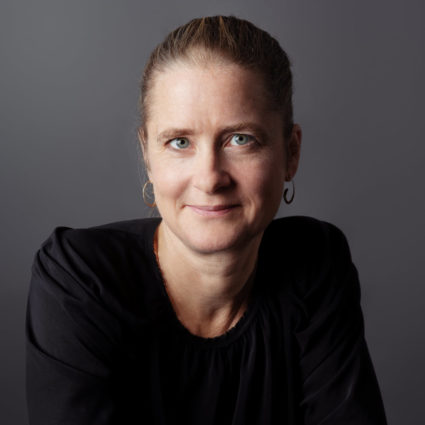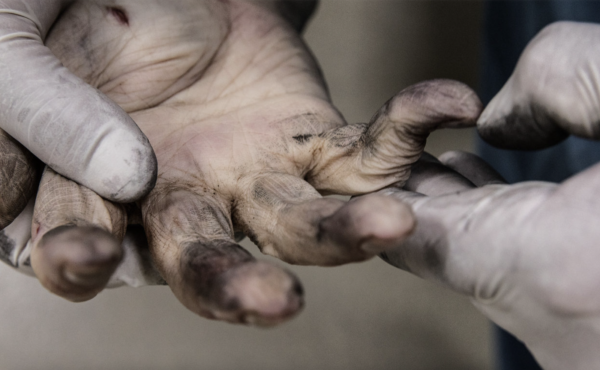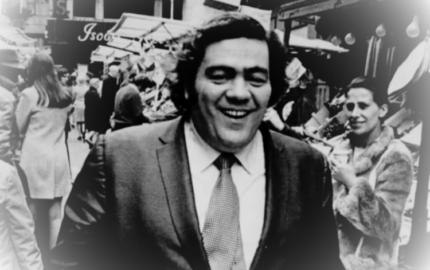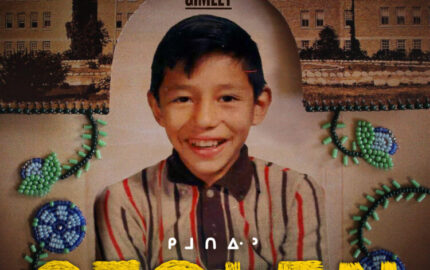A few years ago, Line Vaaben was eating a traditional Christmas dinner at her home in Copenhagen. Vaaben, a 2014 European Press Prize finalist, remembered a story that followed a potato from the field to a bag of french fries. Part of a 1999 Pulitzer-winning series in The Oregonian, Richard Read used the potato’s journey to show the shifting fortunes of globalization.
Now, as Vaaben ate, she had an idea: She would follow a piglet from birth to pork roast. That spring, as birthing time approached, she found a farmer and then witnessed the birth of a piglet labeled 1069. For the next several months, she followed 1069 as it was coddled and fed, then sent to slaughter. She watched as it was drugged, killed and butchered. She carted the resulting 8 kilos (almost 18 pounds) of meat home by bus and car.

Once there, using her grandmother’s recipe, she roasted the pork in sauce and cucumbers and, with great care, served Christmas dinner. As her son wolfed tender and juicy slices of meat, Vaaben pondered her plate and the cycle of life.
In her reporting, Vaaben learned that farmers treat their livestock with great respect, but don’t name those raised for market. But at her table that day, with gratitude for the pig that had fed her journalism and now fed her family, Vaaben gave 1069 a name: Yule.
Then she stopped eating pork.
Farmers, meat industry officials and animal rights activists thanked Vaaben for the story: She had gotten it right. I haven’t read it, my Danish being nonexistent. But I’ve heard Vaaben talk about it, most recently at the Fortellingens Kraft 22, a narrative journalism conference in Bergen, Norway, this week. It was one of three of Vaaben’s stories featured in a conversation with Pulitzer-winner Tom French about the purpose, power and practice of narrative journalism.
An autopsy as narrative
Vaaben is one of the most respected journalists in Denmark. If more of her work were published in English, her reach would go well beyond. Like most journalists with 20-plus years in the field, she has covered most everything. But she soon gravitated to narrative, not just as a craft but as a meaningful exploration of the human condition in all its wonder and complexity, messiness and mystery.
One of her stories is “He should have been a boy.” It follows Daniel, who was born as Linda, on his journey to become the person he felt he really was. That piece has, thankfully, been translated to English. As is the narrative Vaaben wrote after gaining access to the autopsy of a murder victim, and then the crime scene itself. The story, published in Dagbladet Information, begins like this:
He is lying on a steel table. A middle-aged man with skin the colour of wax. His chest is punctuated by a series of gaping knife wounds, which gleam a deep red, and from a neck wound a little blood seeps out and creates a pool on the shining metal. The smell of the place is reminiscent of an open fridge, a whiff of decay, cold and sweet.
Vaaben takes readers into a cellar room at Aarhus University Hospital, where we meet forensic pathologist Asser Hedegård Thomsen, who has studied the 1,417 homcides committed in Denmark between 1992 and 2016, and performed more than 50 himself.
Vaaben’s story is graphic but never gratuitous. As the story unfolds, readers are aware of the respect the autopsy team gives to the dead, and the commitment they have to letting science help find justice. Consider this passage:
The autopsy feels most brutal when you dwell on details that remind you of a lived life: the lifelines in the hands, the stubble speckled with grey, the toenails that need cutting. But as the autopsy progresses the man gradually become more flesh and less human. Asser Hedegård Thomsen is fully aware that it is invasive.
“When I carry out my work, I do things that I would prefer not to do. I have no desire to open up this man’s skull, but I do it because I have to. And I don’t walk in off the street and do it for fun. They have called me because there is a job that needs to be done.”
Once in a while in his thoughts he might comfort the person lying on the table.
“I can find myself thinking, ’There, there. It’s a shame that the two of us have to meet like this.’ Especially when it’s children, it’s heartbreaking. But then I remind myself that this knowledge is needed. And we do try to do it in a thorough and decent way.”
Just as the forensic team scours for telling details from the victim’s body, Vaaben scours for details that brings their story — and their purpose — to life for the reader. She zooms in close, noticing small things that hold deep meaning. She ends back at the crime scene, where a man’s life ended, and watches as a police officer named Jørn checks the space and seals it until the investigation is done:
In the victim’s house, the blinds are drawn. Jørn shines a torch round the sitting room. On the coffee table there is a mouthful of coffee in a cup next to a remote control, a completed lottery coupon and half a packet of cigarettes.
“It’s a clean and tidy home,” he says. “Apart from all the blood, that is.” And there is plenty of that. Especially on the carpet in the sitting room, where a thick and sticky spread indicates where the victim had been lying. There is also blood on the sofa and the armchair and small star-shaped splashes on the walls several yards away. One of them has hit a little framed black-and-white photo of the victim as a child.
A wall calendar signals that the dead man had an appointment with the doctor next week. In the kitchen, an apple lies all by itself in a fruit bowl and in a bag the crust of a homemade loaf of bread. But in the knife rack one knife is missing.
Jørn empties a carton of whole milk out of the fridge and brings the rubbish bag outside. The crime scene will be sealed off for several months, until the case is finally concluded.
“It could be a long time before anyone comes in here again,” he says.
Lessons learned and shared
I first met Vaaben several years ago when she attended a writing workshop at the Poynter Institute. She has since attended two of my own writing workshops and attends every serious conference she can. She not only absorbs experience and wisdom, she applies it. She used a fellowship to collect lessons from some of the top narrative journalists in the world for a textbook. She co-authored, with the forensic pathologist from the autopsy story, a soon-to-be-released book on femicide in Denmark. Those, too, are only available in Danish, but Vaaben has shared some of her hard-earned wisdom in previous Storyboard posts. Here are a few more, in capsule form, from the Bergen conference:
On her belief in narrative: “Narrative storytelling is the most powerful tool we have. You write directly into people’s bodies and emotions.”
On the best narrative journalists: “Of course they are very curious people, but they also are very patient. They know it’s not about them.”
Other Storyboard posts from Line Vaaben
On finding ideas: “Steal ideas you’ve seen in other stories and make them your own.”
On fearless reporting: “I’m not afraid of asking questions. Some are hard to ask. But my curiosity will always win.”
On being on the scene: “You don’t know what’s going to happen until you’re there. There’s always a bonus there, something that surprises or disgusts or amazes you. Reality is just stunning.”
On reporting for detail: “We use our eyes and ears a lot, but we need to use all the senses. Smell is the king of senses.”
On handling her emotions in the field: “I’m a very emotional person. But at work, I’m very professional. I’m aware of everything going on, but I don’t cry and I try not to faint. When I get back and go through my notes, then I’m under the floor. And I cry when I read other stories.”
On her relationship with story subjects: “It’s tempting to become their social worker, to give them advice. But don’t do that. Sit on your hands and keep your mouth shut.”
On the terror of writing: “I gather all this incredible material for a story. But when I finally sit down to write, I curl up in a ball of panic. I’m aware that there’s only one person who can fuck-up this right now, only one person who stands between all this wonderful material and a masterpiece. And that’s me.”
On getting past the terror: “Structure. Map out where your story is going.”
On her role as narrator: “My (writing) voice is very quiet. Normally I don’t want to be present in my stories; I want the story to speak for itself. And the more dramatic the events, the more I pull back and just lay out what happened.”
On quotes and dialog: “I’m trying to get rid of quotes, and only use those that are like a smash in volleyball. Journalists can usually tell the story better than most sources.”
On endings: “I want endings that linger with you and that you keep thinking about.”
On purpose: “I’m trying to change the world narrative by narrative, not by covering politics, but by changing people’s views. I want to challenge people’s views on other human beings.”



